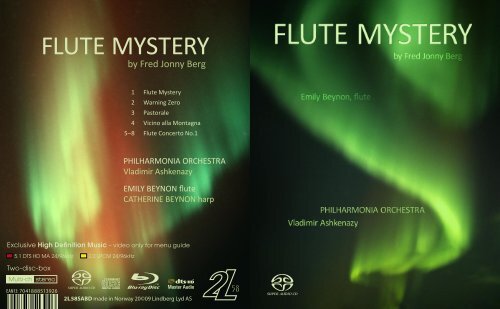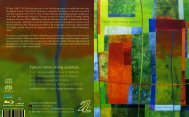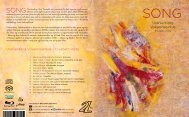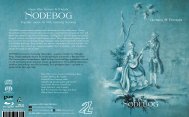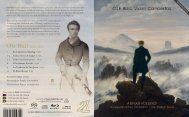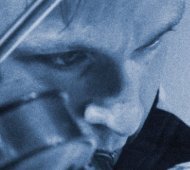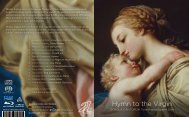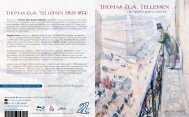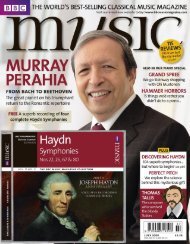FLUTE MYSTERY e
2L58SABD_eBook.pdf
2L58SABD_eBook.pdf
You also want an ePaper? Increase the reach of your titles
YUMPU automatically turns print PDFs into web optimized ePapers that Google loves.
<strong>FLUTE</strong> <strong>MYSTERY</strong><br />
by Fred Jonny Berg<br />
1 Flute Mystery<br />
2 Warning Zero<br />
3 Pastorale<br />
4 Vicino alla Montagna<br />
5–8 Flute Concerto No.1<br />
PHILHARMONIA ORCHESTRA<br />
Vladimir Ashkenazy<br />
EMILY BEYNON flute<br />
CATHERINE BEYNON harp<br />
Exclusive High Definition Music – video only for menu guide<br />
5.1 DTS HD MA 24/96kHz 2.0 LPCM 24/96kHz<br />
Two-disc-box<br />
Multi-ch stereo<br />
e q<br />
EAN13: 7041888513926<br />
2L58SABD made in Norway 20©09 Lindberg Lyd AS<br />
58<br />
e
<strong>FLUTE</strong> <strong>MYSTERY</strong><br />
by Fred Jonny Berg<br />
1 Flute Mystery Op.66b 14:12<br />
2 Warning Zero Op.54b 10:02<br />
3 Pastorale Op.32 No.1 1:51<br />
4 Vicino alla Montagna Op.58b 12:24<br />
Flute Concerto No.1 Op.70<br />
5 I Memento 7:16<br />
6 II Reminiscence 5:06<br />
7 III Obituary 1:51<br />
8 IV Awakening 4:45<br />
Emily Beynon, flute (1, 5-8)<br />
Catherine Beynon, harp (1)<br />
Philharmonia Orchestra<br />
Vladimir Ashkenazy, conductor (1, 5-8)<br />
Fred Jonny Berg, conductor (2-4)<br />
Op.66 is dedicated to Sir James Galway. Alto flute version (Op.66a)<br />
first performed in 2006 by Galway and National Symphony Orchestra,<br />
conducted by Leonard Slatkin<br />
Op.70 is dedicated to Emily Beynon. First performed in 2009<br />
by Beynon and Philharmonia Orchestra, conducted by Vladimir Ashkenazy<br />
Fred Jonny Berg (b. 1973) is a distinctive and innovative Norwegian composer with an<br />
unusually rich palette of sounds and textures at his disposal. His music covers a wide<br />
range of genres and is scored for a great variety of ensembles. All of his works bear the<br />
unmistakable imprint of strong originality and authenticity. In addition to his extensive<br />
composing career Fred Jonny Berg has also had considerable success as a writer, singer<br />
and film maker.<br />
A musical polymath, naturally sensitive to the humanistic qualities of music, Berg is<br />
concerned with areas of tension between melos and form, light and dark, burlesque<br />
humour and profound melancholy. Powerful melodic emotions are juxtaposed with<br />
vertical and horizontal structures where diatonic, polytonal and modal harmonies<br />
have a natural place within his musical universe. Berg’s distinctive, even liberating idiosyncratic<br />
approach to musical language constantly amazes: his voice comes across<br />
clearly and unmistakably as his own; as a voice which cannot be ignored.<br />
Berg is one of a handful of composers who are able to create the rare experience of<br />
enchanted silence in their music – Berg’s Flute Concerto No.1 Op.70 contains several<br />
such moments. Even though his tools are a “conventional” orchestra using “conventional”<br />
instruments, an unreal atmosphere of calm and celestial flight arises. One of the<br />
most fascinating aspects in this regard is that he does not use any minimalist or modernist<br />
devices at all; he simply allows the music and its inner qualities to speak in full. In our<br />
current age of constant hectic activity, where it is barely permitted to think a complete<br />
thought, music such as this is of the greatest importance: it gives the listener the chance<br />
to experience time as a benefit and not as a punishment. The concerto is dedicated to<br />
the Royal Concertgebouw Orchestra’s eminent flautist Emily Beynon, and it received its<br />
premier performance in London in February 2009.<br />
Flute Mystery Op.66b – the title track of this recording – is another example of a calm,<br />
enchanted work in which the sounds of conventional instruments meld together to<br />
produce a fascinating new entity. Just listen to the first few cautious notes, orchestrated<br />
as unison between flute and harp; they reach out beyond our everyday lives to a timeless<br />
realm which supports the entire work.<br />
From a technical point of view Berg’s music is governed by an unfailing, intuitive<br />
understanding of the instruments’ physiology and the distinctive auditory character<br />
and potential of the ensembles; however it is never the craftsmanship which comes<br />
first in his music – it is the overall artistic flow. This work also exists in a version for<br />
alto flute (Op.66a).
Fred Jonny Berg as pictorial artist is also abundantly present in his music – Vicino alla<br />
Montagna Op.58b is music to a film with the same title. Berg paints landscape panoramas<br />
with a steady, sure hand. And, from his point of view as a film maker, he seeks<br />
long lines in the artistic discourse – like Richard Strauss in his Alpensinfonie he uses<br />
the entire expressive register of the orchestra to describe the magnificent peaks in<br />
all their inward and outward facets. Unlike Strauss, however, Berg’s portrayal is<br />
darker and more stringent: we are certainly not in the Alps, rather in the weatherbeaten<br />
mountains of northern Norway where nature, not man, decides.<br />
Berg’s tone-poem Warning Zero Op.54b is another example of his ability to paint sounds<br />
with energy. The brass are responsible for an almost apocalyptic assault on the listener<br />
– there is something threatening and inevitable about the music; even in the brighter<br />
woodwind passages the music does not rest, wandering in search of lost calm.<br />
Pastorale Op.32 No.1 is an apparently bright and care-free composition which only after<br />
a while begins to worry us – this is due to the elegant use of bitonality which gives the<br />
piece a veritable Janus face. We are treated to another example of Berg’s compositional<br />
ambiguity – one of the principal elements of his music – in a work which is open to interpretation<br />
in any direction. The home key is F, constantly “undermined” by C sharp minor<br />
and D flat major tonalities.<br />
In his music Fred Jonny Berg reveals himself as a person who has experienced that life<br />
consists of light and dark – but unlike the majority of us he approaches both with a<br />
similar undaunted decisiveness; it adds an extra quality to his music: the conviction of<br />
an eyewitness.<br />
Wolfgang Plagge, 2009<br />
Since Vladimir Ashkenazy came to prominence in the 1955 Chopin Competition in<br />
Warsaw he has built an extraordinary career as one of the most renowned pianists<br />
of our times and an artist whose creative life encompasses a vast range of activities<br />
offering inspiration to music-lovers everywhere. Currently Principal Conductor and<br />
Artistic Advisor to the Sydney Symphony<br />
Orchestra, he maintains a warm<br />
relationship with the Philharmonia as<br />
their Conductor Laureate.<br />
Ashkenazy continues to devote himself<br />
to the piano, now mostly in the<br />
recording studio where he regularly<br />
adds to his comprehensive recording<br />
catalogue with releases such as<br />
the 1999 Grammy award-winning<br />
Shostakovich Preludes and Fugues,<br />
Rautavaara’s Piano Concerto No.3<br />
(a work which he commissioned).<br />
Most recently released are recordings<br />
of Bach’s Wohltemperierte Klavier,<br />
Beethoven’s Diabelli Variations and in<br />
summer 2009 a recording of French<br />
piano duos with Vovka Ashkenazy.<br />
I am very fond of Scandinavian mentality, the way people<br />
express themselves and their spiritual world. It has always<br />
been a very special treat for me to conduct and play Scandinavian<br />
music and it is a particular pleasure to introduce to<br />
the world a very talented Norwegian composer Fred Jonny<br />
Berg whose music in its own way is a genuine reflection of<br />
his world.<br />
Emily Beynon is principal flute of the<br />
Royal Concertgebouw Orchestra, Amsterdam.<br />
Born in Wales, she began her musical education at the Royal College of Music<br />
(Junior Department) and then went on to study with William Bennett at the Royal<br />
Academy of Music and with Alain Marion in<br />
Paris.<br />
She performs regularly as concerto soloist<br />
and chamber musician, appears regularly<br />
on BBC Radio 3 and has recorded 8 solo CDs.<br />
A passionate and dedicated teacher, Emily<br />
is frequently asked to give masterclasses all<br />
over the world. Emily was made a Fellow of<br />
the Royal Academy of Music in 2002.
Catherine Beynon began playing the harp at the age of eight, and attended the Royal<br />
College of Music Junior Department with Daphne Boden and later gained a scholarship<br />
to the Royal Academy of Music. Catherine then completed her studies at the Conservatoire<br />
Superieur de Music in Lyon with Fabrice Pierre. Since September 2003 Catherine<br />
has been principal harp in the Orchestra Philharmonic du Luxembourg.<br />
Acknowledged as the UK’s foremost musical pioneer, with an extraordinary recording<br />
legacy, the Philharmonia Orchestra leads the field for its quality of playing, and for<br />
its innovative approach to audience development, residencies, music education and<br />
the use of new technologies – including webcasts, podcasts, downloads and computer<br />
games – in reaching a global audience. Together with its relationships with the world’s<br />
most sought-after artists, most importantly its Principal Conductor Esa-Pekka Salonen,<br />
the Philharmonia is at the heart of British musical life.<br />
Fred Jonny Berg was born in Harstad, north Norway, on 27 May 1973. Since the beginning<br />
of his composing career he has distinguished himself with his distinctively original<br />
voice which in many regards<br />
is at odds with the conventional<br />
trends and “isms” of contemporary<br />
art in general. It is thanks<br />
to his sheer enthusiasm that<br />
he has acquired considerable<br />
knowledge of composing and performing<br />
on several instruments;<br />
he is the very archetype of a multitalented,<br />
musical polymath.<br />
It is really as simple as it is complicated: I breathe in what life has<br />
to offer, and breathe out what I have to offer life. I have given up<br />
trying to grasp what actually happens in the process from impression<br />
to expression.<br />
Fred Jonny Berg’s artistic project<br />
is geared towards the one goal of<br />
producing a genuine, acoustical<br />
result – something he is remarkably<br />
successful in achieving. Like<br />
his colleague Iannis Xenakis he has<br />
a multi-faceted background which<br />
includes both practical and aesthetical disciplines. His wide experience of everything<br />
from electronics and visual media to local radio and musical-historical research has<br />
contributed to his broad field of expertise and understanding of a wide variety of subjects.<br />
This has benefitted his music at many levels and is one of the reasons behind his<br />
distinctive originality as a composer. His many diametrically different interests produce<br />
fascinating results in his compositional sound-world and in numerous other artistic areas<br />
such as film, writing and directing, and in his activities as a lecturer and business<br />
manager.<br />
Berg’s catalogue of works comprises about 200 titles, more than 70 opuses which include<br />
a number of commissioned works; over the years he has collaborated with many<br />
internationally renowned artists including Vladimir Ashkenazy, Sir James Galway and<br />
Leonard Slatkin.<br />
Fred Jonny Berg’s sheet music is available online for evaluation and delivery. All scores<br />
are available for free: www.symbiophonic.as<br />
Through the website you can evaluate and purchase sheet music easy and convenient.<br />
Your purchased sheet music is available as PDF, and can be bundled and downloaded at<br />
any time through the custom made interface. You are also able to choose from different<br />
set-up alternatives when bundling your parts. Alternatively, Symbiophonic can manufacture<br />
a complete set of paper copies for requested works.
<strong>FLUTE</strong> <strong>MYSTERY</strong><br />
av Fred Jonny Berg<br />
Komponisten Fred Jonny Berg (f. 1973) er en særegen og kreativ norsk skapende kunstner<br />
med en usedvanlig rikholdig klangpalett. Hans musikk spenner over et vidt felt av<br />
sjangere og besetninger, og alle verk fra hans hånd bærer umiskjennelige trekk av en<br />
sterk originalitet og autentisitet. I tillegg til sin utstrakte virksomhet som komponist har<br />
han også gjort seg bemerket som tekstforfatter, visesanger og filmskaper, og evner å<br />
kommunisere vesentlige verdier innen alle disse ulike feltene.<br />
Som det musiske menneske han er, er han opptatt av spenningsfeltene mellom melos<br />
og form, mellom lys og mørke, burlesk humor og dyp melankoli. Kraftfulle melodiske<br />
emosjoner står mot loddrette og vannrette strukturer der så vel diatonikk, modalitet<br />
og flertonalitet finner en naturlig plass i helhetsbildet. I det hele tatt forbløffer Berg<br />
stadig ved sin egenartede, ja, i flere sammenhenger rent ut befriende egenrådige<br />
omgang med det musikalske språket: Han fremstår med en klar, tydelig og umiskjennelig<br />
Berg’sk stemme som ikke lar seg overhøre.<br />
Berg er blant de ytterst få komponister som evner å skape noe så sjeldent som en fullstendig<br />
forhekset stillhet i musikk – hans Flute Concerto No.1 Op.70 inneholder flere<br />
slike øyeblikk. Selv om verktøyene hans er et ”vanlig” orkester med ”vanlige” instrumenter,<br />
oppstår en helt uvirkelig stemning av ro og overjordisk himmelflukt. Det mest<br />
fascinerende i så måte er at han ikke på noen måte anvender minimalistiske eller andre<br />
modernistiske virkemidler, men rett og slett lar musikken og dens indre valører få komme<br />
fritt til orde i sin hele og fulle bredde og lengde. I en samtid der hektisk jag og mas er<br />
standard, og der det nærmest er forbudt å tenke en tanke til ende, blir slik musikk rett<br />
og slett meget viktig: Den tilfører lytteren en opplevelse av at tid er et gode og ikke en<br />
straff. Konserten er tilegnet Royal Concertgebouw Orchestra sin eminente fløytist Emily<br />
Beynon og ble urframført i London i februar 2009.<br />
Flute Mystery Op.66b – tittelverket på denne innspillingen – er også et slikt trolsk og<br />
stillferdig verk der konvensjonelle instrumenter får vokse sammen til en fascinerende<br />
ny enhet. Hør bare på de første varsomme tonene i stykket, orkestrert unisont mellom<br />
fløyte og harpe; de berører en tidløshet utenfor hverdagen som får lov å bære stykket<br />
hele veien.<br />
Rent teknisk styres Bergs musikk av en usvikelig intuitiv forståelse for instrumentenes<br />
fysiologi og ensemblenes klanglige egenskaper og forutsetninger, men i hans verker er<br />
det aldri det håndverksmessige som kommer først – det er den artistiske flyten og helheten.<br />
Verket finnes også i en versjon for altfløyte (Op.66a).<br />
Bildeskaperen Fred Jonny Berg er også i rikt monn til stede i musikken hans – Vicino alla<br />
Montagna Op.58b er musikk til en film med samme tittel. Her maler han med bred og<br />
sikker pensel store naturpanoramabilder. Også som filmskaper søker han de lange linjer<br />
i det kunstneriske forløpet – som Richard Strauss i sin Alpensinfonie bruker han hele<br />
orkesterets enorme uttrykksregister for å skildre fjellet i alle sine indre og ytre fasetter.<br />
Men ulikt Strauss holder han sin skildring i en gjennomgående mørkere og strengere<br />
toneverden: Vi er definitivt ikke i Alpene – snarere i et værhardt nordnorsk fjellmassiv<br />
der naturen bestemmer, ikke menneskene.<br />
Det symfoniske diktet Warning Zero Op.54b er likeens et eksempel på komponistens<br />
evne til å skape lydmalende energi. Her får orkesterets messingblåsere hovedansvaret i<br />
et nærmest apokalyptisk angrep på oss som lyttere – det er noe truende og uunngåelig<br />
over denne musikken, selv i de lysere treblåser-avsnittene gir den oss ikke hvile, men<br />
virrer omkring på leting etter den tapte ro.<br />
Pastorale Op.32 No.1 er en tilsynelatende ubekymret og lys liten komposisjon som først<br />
etter en tid begynner å bekymre oss – dette skyldes den elegante bruken av et bitonalt<br />
klangbilde som får stykket til å framstå med et veritabelt Janus-ansikt. Komponisten gir<br />
oss her nok et eksempel på sitt kompositoriske tvisyn – ett av de vesentligste karaktertrekkene<br />
ved hans musikk – i et verk som kan tolkes i absolutt alle retninger. Stykkets<br />
hovedtoneart er en trygg og ubekymret F-dur, som hele tiden ”undergraves” av cissmoll-<br />
og Dess-dur-tonaliteter.<br />
Berg fremstår gjennom sin musikk som et menneske som har erfart at livet består av<br />
så vel lyse som mørke elementer – men i motsetning til de fleste av oss klarer han å<br />
forholde seg til både lys og mørke med den samme uredde besluttsomhet; det tilfører<br />
hans musikk en ekstra kvalitet: Øyenvitnets troverdighet.<br />
Wolfgang Plagge, 2009
I løpet av årene som har gått siden Vladimir Ashkenazy først ble internasjonalt kjent<br />
under Chopin-konkurransen i Warzawa i 1955 har han bygget opp en usedvanlig<br />
karriere – ikke bare som en av de mest anerkjente og respekterte pianistene i vår tid,<br />
men som en artist med en skapervirksomhet<br />
som omfatter<br />
et bredt spekter av aktiviteter<br />
og som stadig inspirerer musikkelskere<br />
over hele verden.<br />
Selv om dirigering utgjør en<br />
betydelig del av hans aktiviteter<br />
hvert år, vier Ashkenazy allikevel<br />
tid til klaverspill og har i<br />
de senere år supplert sin egen<br />
rikholdige katalog av innspillinger<br />
med blant de Grammy-belønnede<br />
Sjostakovitsj-preludier<br />
og fuger, samt Bachs Das Wohltemperierte<br />
Klavier.<br />
Jeg er meget glad i det skandinaviske tankesettet, måten folk uttrykker seg og deres tankeverden. Det har alltid vært<br />
en fornøyelse å dirigere og framføre skandinavisk musikk. Det er en spesiell glede for meg å introdusere den meget<br />
begavede norske komponisten Fred Jonny Berg. Musikken reflekterer hans verden på en genuin måte.<br />
Emily Beynon er solofløytist i Royal Concertgebouw Orchestra i Amsterdam. Hun er<br />
født i Wales og studerte først ved Royal College of Music før hun fortsatte studiene med<br />
William Bennett ved Royal Academy of Music og med Alain Marion i Paris.<br />
Selv om Emily Beynon er ensemblemusiker føler<br />
hun seg like hjemme som solist, og har spilt solo<br />
med blant andre Royal Concertgebouw Orchestra,<br />
Philharmonia Orchestra og de største BBCorkestrene.<br />
Som kammermusiker spiller hun jevnlig<br />
sammen med sin søster, harpisten Catherine<br />
Beynon, og har hatt en rekke gjesteopptredener<br />
med ledende ensembler og instrumentalister. Hun<br />
gjør ofte radioopptak for BBC og har spilt inn flere<br />
solo-CDer.<br />
Catherine Beynon begynte å spille harpe åtte år gammel. Hun var elev på ungdomsavdelingen<br />
ved Royal College of Music med Daphne Boden, og fikk senere et stipendium<br />
til å studere ved Royal Academy of Music. Hun fullførte studiene ved Conservatoire Supérieur<br />
de Musique i Lyon med<br />
Fabrice Pierre. Siden september<br />
2003 har Cathrine Beynon<br />
vært soloharpist i Orchestra<br />
Philharmonic du Luxembourg.<br />
Philharmonia Orchestra er<br />
anerkjent som en av Storbritannias<br />
fremste musikkpionerer.<br />
Med sin unike og rikholdige<br />
CD-produksjon hylles<br />
orkestret for den høye kvaliteten<br />
i spillet og for sin nyskapende<br />
tilnærming til publikumsutvikling,<br />
residenser,<br />
musikkutdanning og bruk av ny<br />
teknologi – webcasts, podcasts,<br />
nedlasting og dataspill – for å<br />
nå publikum over hele verden.<br />
Med sitt samarbeid med de mest etterspurte artistene i dag – og særlig sjefdirigenten<br />
Esa-Pekka Salonen – befinner Philarmonia Orchestra i hjertet i Storbritannias musikkliv.<br />
Komponisten Fred Jonny Berg er født i Harstad 27. mai 1973. Som komponist har han<br />
helt fra starten markert seg med en høyst individuell og karakteristisk stemme som<br />
i mange henseender går på tvers av de vanlige trender og ismer i samtidskunsten for<br />
øvrig. Han har av ren begeistring tilegnet seg store faglige kunnskaper både som komponist<br />
og utøver på en rekke ulike instrumenter, og han fremstår i dag som selve arketypen<br />
på det klassiske multibegavede musiske menneske.<br />
Hele hans kunstneriske virksomhet er spisset med det ene mål for øye å målbære<br />
et genuint klanglig resultat, noe han i forbløffende grad lykkes med. Som sin kollega<br />
Yannis Xenakis har han en særdeles mangesidig bakgrunn der både praktiske og<br />
estetiske disipliner inngår. Hans utstrakte erfaring med alt fra elektronikk og visuelle<br />
media til nærradio og musikkhistorisk forskning har bidratt til stor faglig bredde og innsikt<br />
innen en mengde ulike felter. Dette har kommet hans musikk til gode på mange
plan og er en av årsakene til hans betydelige originalitet som komponist. De mange til<br />
dels diametralt forskjellige interessene gir seg konkrete og fascinerende utslag både i<br />
hans klangverden som komponist og innen et utall andre arbeidsområder som filmkunst,<br />
forfattervirksomhet og regi, og i hans virksomhet som foredragsholder og bedriftsleder.<br />
Bergs verkliste omfatter mer enn 200 titler,<br />
inklusive mer enn 70 opus, deriblant en rekke<br />
bestillingsverker. Han har gjennom årene samarbeidet<br />
med internasjonalt fremtredende kunstnere<br />
som Vladimir Ashkenazy, Sir James Galway,<br />
Leonard Slatkin og mange andre.<br />
Blu-ray is the first domestic format in history that unites theatre movies and music<br />
sound in equally high quality. The musical advantage of Blu-ray is the high resolution<br />
for audio, and the convenience for the audience as one single player will handle music,<br />
films, their DVD-collection and their old library of traditional CD.<br />
What we are seeing is a completely new conception of the musical experience. Recorded<br />
music is no longer a matter of a fixed two-dimensional setting, but rather a three-dimensional<br />
enveloping situation. Stereo can be described as a flat canvas, while surround sound<br />
is a sculpture that you can literally move around and relate to spatially; with surround you<br />
can move about in the aural space and choose angles, vantage points and positions.<br />
En rekke verker finnes innspilt på CD.<br />
Mer informasjon: www.fjb.no<br />
Det er i grunn like enkelt som det er komplisert: Jeg puster inn det livet har å tilby og puster ut det jeg har å tilby livet.<br />
Hva som skjer i prosessen fra inntrykk til uttrykk har jeg for lengst gitt opp å begripe.<br />
By developing one common format the surround technology that we have been working<br />
with for years finally becomes accessible to the general public. Fairly soon almost all disc<br />
players will be Blu-ray devices, and already now a majority of the sound systems that<br />
come off the shelf are 5.1 surround systems. People buy the equipment for the sake of<br />
film entertainment, but with it they get access to the unique musical experience that we<br />
are offering. Stereo is still possible of course, but the fact is that the resistance towards<br />
surround is mostly based on ignorance. People just don’t know what they are missing<br />
out on.
A senior Norwegian HiFi journalist visited our studio recently. Prior to our listening session<br />
I explained to him how we recorded with the orchestra in a circle, all musicians<br />
facing each other – surrounding the listener. He rose from his chair and wanted to leave.<br />
I begged him to listen - and he stayed for three hours; leaving us with the conclusion:<br />
“Now I need to go home and write an article apologising all my readers for the thirty<br />
years I have misguided them in stereo. Surround sound is the real thing.”<br />
The musical and technical process of recording and editing are identical for SACD and<br />
Blu-ray. When I started as a recording engineer in 1990 there was no focus on surround<br />
sound in classical music. It was the introduction of SACD that made us aware of this<br />
magnificent perspective. Surround sound gave us the solution to the depth and spatial<br />
resolution we experienced live on stage in a concert house, but were not able to recreate<br />
in stereo.<br />
We prefer to record in spacious acoustic venues; large concert halls, churches and<br />
cathedrals. This is actually where we can make the most intimate recordings. The qualities<br />
we seek in large rooms are not necessarily a big reverb, but openness due to the<br />
absence of close reflecting walls. Making an ambient and beautiful recording is the way<br />
of least resistance. Searching the fine edge between direct contact and openness; that’s<br />
the real challenge.<br />
= Section leader<br />
Vln 1<br />
Vln 1<br />
Vln 1<br />
Vln 1<br />
Vln 1<br />
Vln 1<br />
Vla<br />
Vla<br />
Vla<br />
DB vc DB<br />
vc DB vc<br />
Vln 1<br />
Vln 1<br />
vc<br />
vc<br />
hp<br />
DB<br />
solo<br />
flute<br />
conductor<br />
vc<br />
DB<br />
DB vc<br />
vc DB<br />
DB<br />
Vln 2<br />
Vln 2<br />
vc<br />
Vln 2<br />
Vla<br />
Vla<br />
vc<br />
Vln 2<br />
Vln 2<br />
Vla<br />
Vln 2<br />
Vln 2<br />
A really good recording should be able to bodily move the listener. This core quality of<br />
audio production is made by choosing the right venue for the repertoire, and balancing<br />
the image in the placement of microphones and musicians relative to each other in that<br />
venue. Planning and discussions with the musicians create trust and a sense of occasion<br />
and excitement that translates onto the recordings. What we insist upon in the recording<br />
phase is time. At most projects the entire first day is spent bringing the dimensions<br />
down from a 1500-people hall to the proximity encountered on a home-visit to your living<br />
room. The challenge of this process is to get the volume down, keeping the intensity<br />
and energy up, without being intrusive. There is no method available today to reproduce<br />
the exact perception of attending a live performance. That leaves us with the art of illusion<br />
when it comes to recording music. As recording engineers and producers we need<br />
to do exactly the same as any good musician; interpret the music and the composer’s<br />
intentions and adapt to the media where we perform.<br />
Morten Lindberg, 2009<br />
Flute Mystery
= Section leader<br />
Vln 1<br />
Vln 2<br />
Vln 1<br />
Vln 2<br />
pic<br />
fl1+2<br />
Vln 1<br />
Vln 2<br />
Vln 2<br />
Vln 1<br />
Vln 1<br />
Vln 2<br />
tpt2+3<br />
tpt1<br />
clar1+2<br />
Vln 1<br />
Vln 2<br />
trb1<br />
clar3+4<br />
DB<br />
trb2+3<br />
b.cl<br />
DB<br />
DB<br />
tuba<br />
c.bsn<br />
DB<br />
Gr.C<br />
euph<br />
bsn1+2<br />
DB<br />
tamb<br />
sax<br />
Timp<br />
ob1+2<br />
DB<br />
corno<br />
2+4<br />
vc<br />
DB<br />
corno<br />
1+3<br />
vc<br />
Vla<br />
vc<br />
DB<br />
Vla<br />
vc<br />
vc<br />
vc<br />
vc<br />
Vla<br />
vc<br />
vc<br />
vc<br />
= Section leader<br />
perc<br />
Vln 2<br />
ob1+2<br />
Vln 1<br />
Vln 1<br />
Vln 1<br />
Gr.C<br />
Vln 2<br />
Vln 1<br />
Vln 2<br />
Vln 2<br />
Vln 2<br />
tpt1+2 trb1 trb2+3<br />
Vln 2<br />
Vln 2<br />
Vla<br />
hp<br />
Vla<br />
clar1+2<br />
Vla<br />
Vla<br />
Vla<br />
Vla<br />
vc<br />
vc<br />
Timp<br />
bsn1+2<br />
vc<br />
vc<br />
corno<br />
2+4<br />
vc<br />
vc<br />
corno<br />
1+3<br />
vc<br />
vc<br />
vc<br />
vc<br />
Vln 1<br />
Vln 2<br />
tri / pi<br />
conductor<br />
camp<br />
Vla<br />
Vla<br />
Vln 1<br />
fl1+2<br />
Vln 1<br />
conductor<br />
DB<br />
DB<br />
DB<br />
tuba<br />
DB<br />
DB<br />
DB<br />
Vla<br />
Vln 1<br />
DB<br />
Vln 1<br />
Warning Zero<br />
Vln 1<br />
Pastorale + Vicino alla Montagna<br />
DB
= Section leader<br />
DB DB DB DB DB DB DB DB<br />
Recorded at Watford Colosseum, London<br />
January 2008 by Lindberg Lyd AS<br />
Vln 1<br />
Vln 1<br />
Vln 1<br />
Vln 1<br />
Vln 1<br />
Vln 1<br />
Vln 1<br />
Tubular Bells<br />
Vln 1<br />
1 hn 3 2 hn 4<br />
hp<br />
solo<br />
flute<br />
Glass<br />
Harmonica<br />
tuba<br />
vc<br />
vc<br />
vc<br />
vc<br />
vc<br />
timp<br />
vc vc<br />
vc<br />
vc<br />
vc<br />
Recording producer and balance engineer Morten Lindberg<br />
Recording engineer Hans Peter L’Orange<br />
Assistant engineer Ståle Hebæk Ødegården<br />
Editing Jørn Simenstad<br />
Mix Hans Peter L’Orange and Morten Lindberg<br />
Mastering Morten Lindberg<br />
SACD authoring Lindberg Lyd AS<br />
Vln 2<br />
Vln 2<br />
Vln 2<br />
Vln 2<br />
Vln 2<br />
Vln 2<br />
Vln 2<br />
2 oboe 1<br />
conductor<br />
2 klar 1<br />
2 bsn 1<br />
Vla<br />
Vla<br />
Vla<br />
Vla<br />
Vla<br />
Vla<br />
photo Aurora Borealis Bjarne Riesto<br />
video Aurora Borealis News on Request<br />
photo E Beynon Hanya Chlala • photo Ashkenazy SSO/Keith Saunders<br />
photo E & C Beynon Keith Saunders • Session photos News on Request<br />
Illustrations Lindberg Lyd / Translation Andrew Smith<br />
Biographic information about the artists kindly provided by<br />
Harrison/Parrott Ltd, Philharmonia Orchestra and Symbiophonic AS<br />
Artwork and graphic design Morten Lindberg<br />
ORGAN<br />
Flute Concerto<br />
Executive producers<br />
Fred Jonny Berg (Symbiophonic) and Morten Lindberg (2L)<br />
Financially supported by Symbiophonic AS and Innovation Norway<br />
www.2L.no<br />
2L is the exclusive and registered trade mark<br />
of Lindberg Lyd AS 20©09 [NOMPP0901010-080] 2L58SABD<br />
Worldwide distributed by Musikkoperatørene and www.2L.no
Blu-ray authoring msm-studios GmbH<br />
audio encoding Sven Mevissen • screen design Dominik Fritz<br />
authoring Martin Seer and Markus Ammer<br />
producers Johannes Müller and Morten Lindberg<br />
5.1 DTS HD MA 24/96 kHz 2.0 LPCM 24/96 kHz<br />
This Pure Audio Blu-ray Disc has been designed to offer two ways of operation, either<br />
with or without a TV screen: you can either navigate the on-screen POP-UP MENU or<br />
simply use the dedicated buttons of your remote control. The NUMERIC keys directly<br />
access the corresponding track number and the desired audio stream can be selected by<br />
the COLOURED keys on your remote. 5.1 DTS HD Master Audio is preselected.<br />
This recording was made by Lindberg Lyd with DPA microphones,<br />
Millennia Media amplifiers and SPHYNX2 converters to a PYRAMIX workstation.


